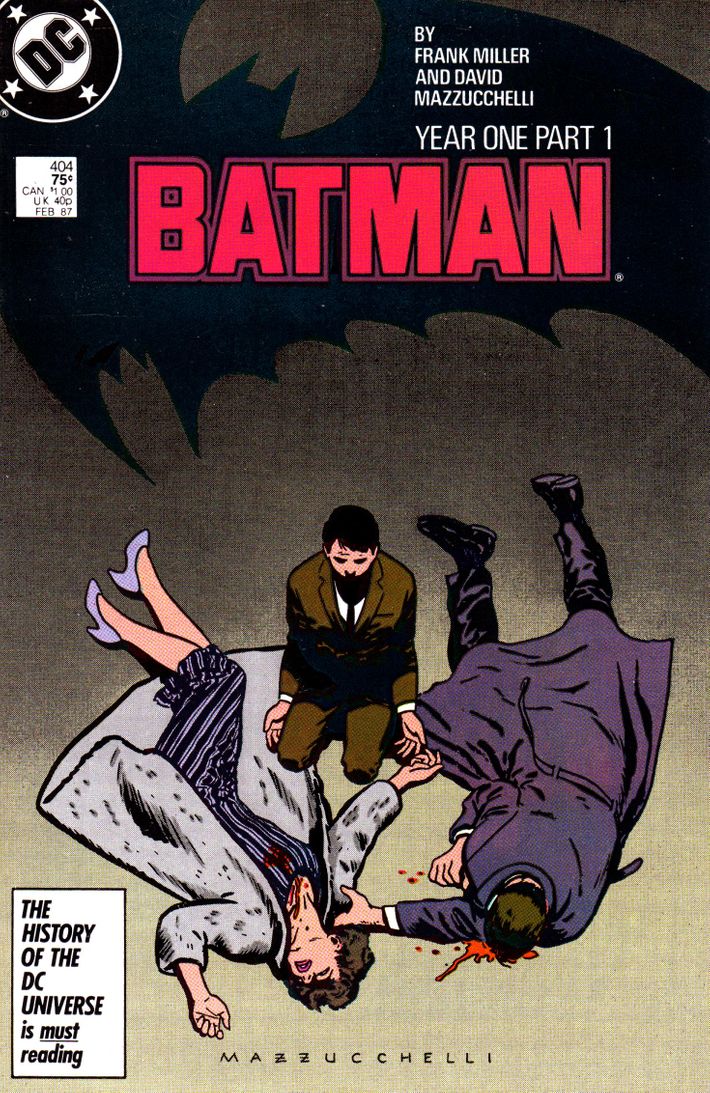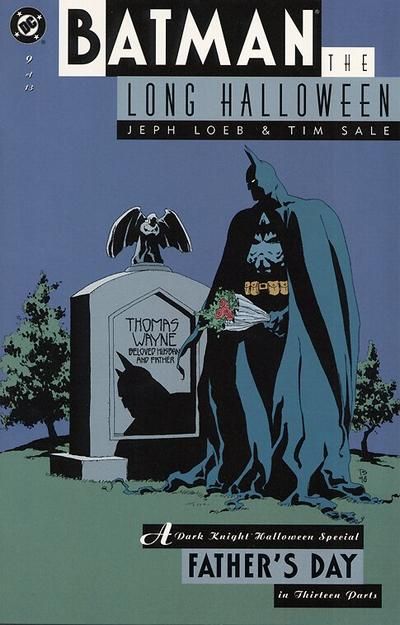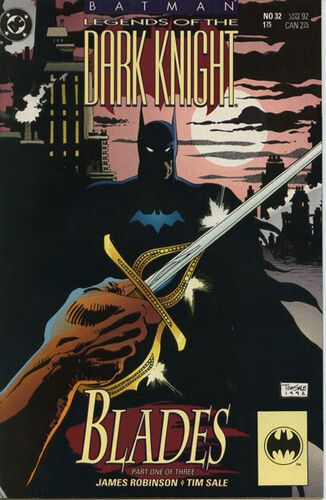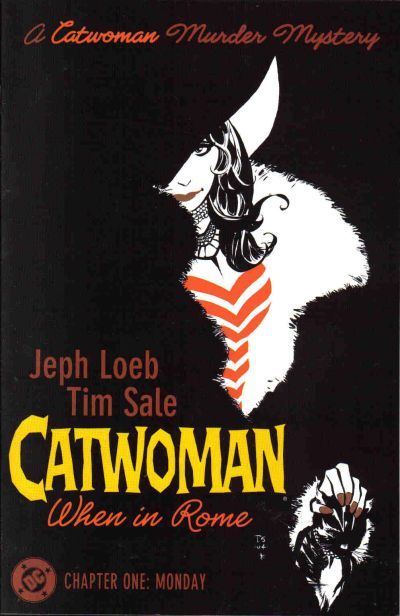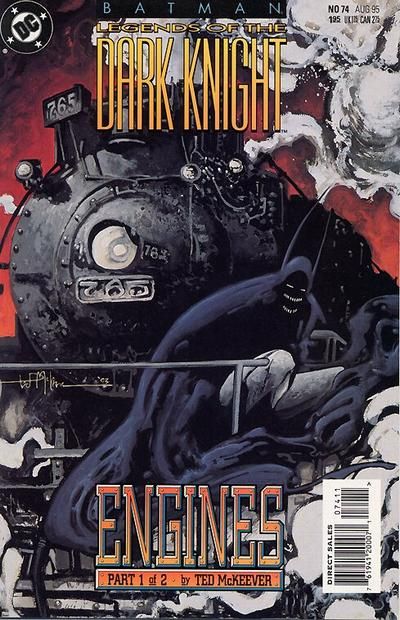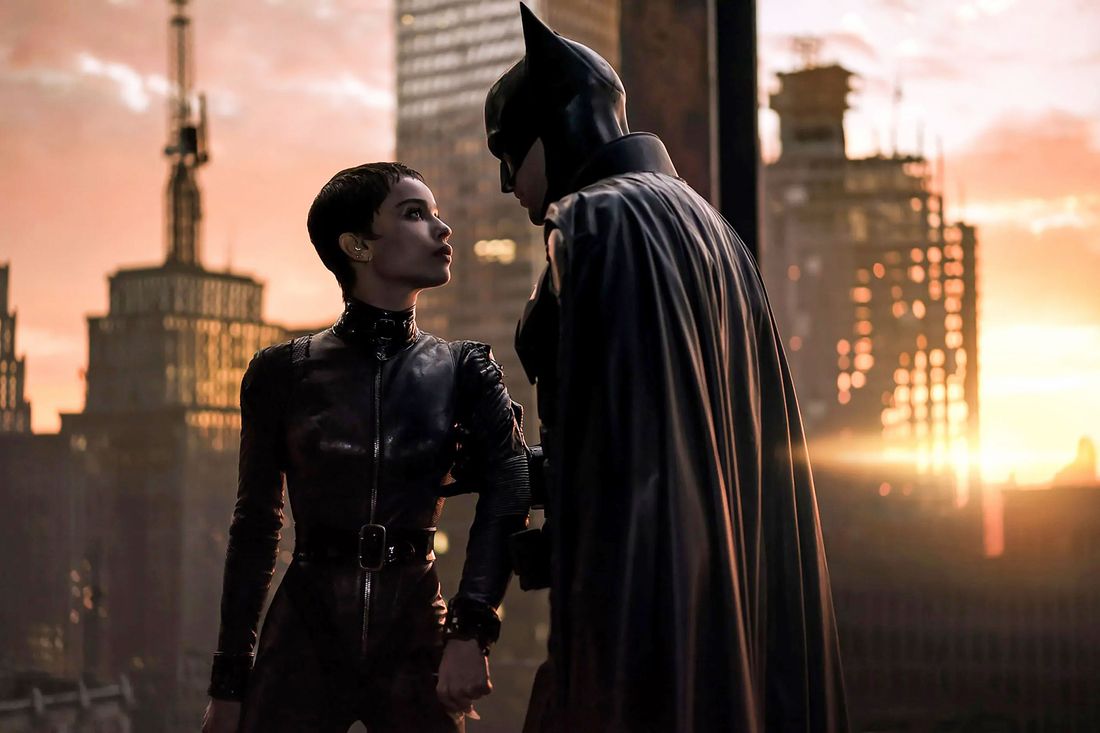
The popularity of superheroes is almost impossible to quantify. Would one weigh box-office receipts against online searches? How about video games and licensed clothing? Do eBay listings count?
There is one place where thereÔÇÖs a clear winner: Comic books, where Batman is the undisputed king. HeÔÇÖs appeared in more individual stories, series, and issues than any other superhero, and that dominance isnÔÇÖt just because heÔÇÖs been around longer than other characters: Last year, the Dark Knight appeared in roughly 100 more issues and more than twice as many series as any other DC or Marvel character. In March 2020, the last complete month the two companies used the same distributor, Comichron recorded its estimated shipments of Batman comics at more than 400,000 issues; Spider-Man was second, at around 250,000. (The gap was even larger when it came to graphic novels: 12,696 to 3,532.)
The massive number of Batman stories poses a challenge for anyone looking for a toehold into that world. A couple of years ago, I began systematically reading and cataloging everything written during whatÔÇÖs referred to as BatmanÔÇÖs ÔÇ£Modern EraÔÇØ to figure out whatÔÇÖs actually worth reading ÔÇö and in what order. The Modern Era began in 1986, the year that, as anyone whoÔÇÖs geeked about comics take pains to tell you, comics like Frank MillerÔÇÖs The Dark Knight Returns upended the entire industry by showing that superhero narratives could be both artistically relevant and profitable at the same time.
In The Dark Knight Returns, Miller, artist Klaus Janson, and colorist Lynn Varley transformed Bruce Wayne from a seemingly ageless and good-natured playboy into a lonesome and bitter 55-year-old man who is a long hard decade removed from his crime-fighting days. WayneÔÇÖs return to BatmanÔÇÖs cape and cowl seemed more driven by disgust than duty, more Dirty Harry than Don Diego de la Vega. The four-issue miniseries was dense and brutal, overtly political and ultraviolent. Its success showed what was possible when one of the worldÔÇÖs best-known superheroes was removed from the constraints of his back catalog. Once Batman wasnÔÇÖt weighed down with continuity questions and the conventions of the category, it was possible to make his motivations more blurred, his personality more mature. As TimeÔÇÖs Lev Grossman put it when he named The Dark Knight Returns one of the best graphic novels ever written, ÔÇ£A major superhero had never felt this real beforeÔÇØ ÔÇö although I think what he really meant was that a major superhero had never felt that real to adults before.
The Dark Knight Returns was published at a pivotal moment for DC: Its first two issues came out just as the company was wrapping up a massive crossover event called ÔÇ£Crisis on Infinite Earths,ÔÇØ which blew up the companyÔÇÖs comically complicated multiverse in favor of one all-encompassing reality. That type of across-the-board hard reboot had never been done in comics before, and it set the stage for ÔÇ£Year One,ÔÇØ a four-issue Batman origin story by Miller that came out in 1987 and changed Batman forever. Miller kept the most basic elements of Bruce WayneÔÇÖs past intact: His parents were still murdered coming out of a movie theater and his alter ego was still inspired when a bat flew through a window at Wayne Manor. But in MillerÔÇÖs hands, the character was grounded in the real world in a way that heÔÇÖd never been in the past. WayneÔÇÖs success was anything but preordained: In the first issue alone, he is stabbed by an underage sex worker, shot by the police, arrested, and at risk of bleeding out. The antagonists were corrupt cops, crooked politicians, and the mob, not purple-haired clowns or clay monsters.
That shift in tone  an expanded emotional palette, moral ambiguity, and an ever-present possibility of failure  would define the character for the next quarter-century. It was so successful that DC started creating new monthly Batman-focused titles, including ones with stories that appeared in no particular order but were from the first decade of Batmans career  years before the stories appearing in the main Batman titles at the time took place. By the time DCs next reboot occurred in 2011, the Modern Era included more than 1,000 issues of Batman-focused content and an additional 1,000-plus issues of Gotham-centric titles like Catwoman, Gotham Central, Nightwing, Robin  you get the idea. The era ended with Grant Morrisons awesomely vertiginous multiyear run on three separate Batman titles, a sprawling and joyous capstone overstuffed with references and allusions to the decades of Batman stories that had already been written. It was a brilliant concluding counterweight to the saga Miller had started, and it left diehard fans ecstatic  and newbies with absolutely no idea where to start.
DC does a singularly awful job at managing its legacy: The company is rarely explicit about what stories exist within normal continuity and what are non-canonical one-offs, and its collected editions are of wildly varying quality, often incomplete, and seem to go out of print as soon as they appear. Numerous Batman timelines are available online, but almost all of them are either too confusing to be helpful or theyÔÇÖre obviously wrong, woefully incomplete, or too complete.
Some people learned new languages or wrote novels during COVID; I made spreadsheets. At press time, my Modern Era Batman timeline/chronology has mushroomed to more than 400 pages. It has become the data set IÔÇÖve used to put together a comprehensive, chronological list that doesnÔÇÖt include everything written ÔÇö just the titles that are important touchstones or actually worth checking out.
The selections here focus on the first five years of the Modern Era, covering BatmanÔÇÖs formative pre-Robin period. They take on an added relevance with the release of director Matt ReevesÔÇÖs film The Batman, starring Robert Pattinson, which takes place during BatmanÔÇÖs second year ÔÇö a time when the Caped Crusader was still unsure of himself and his place in Gotham City. While Reeves ÔÇïÔÇïhas cited several of these titles as inspiration, The Batman draws from a deeper well of comic-book source material than any previous big-screen adaptation. IÔÇÖve included both the titles Reeves has explicitly referred to as well as a handful of other stories that are referenced in his movie; taken together, this loosely chronological selection provides an excellent entre╠üe into the character and his world.
Note: This list includes multi-issue stories that were later packaged as trade paperbacks, stories that were told in single issues of preexisting titles, and ÔÇ£one-shots,ÔÇØ or stand-alone publications that did not appear in an ongoing series. All of the titles below can be purchased in digital format on AmazonÔÇÖs comiXology and are also available on DC Universe Infinite, the companyÔÇÖs subscription-based online portal; several are also available in book form.┬á
YEAR ONE
.
ÔÇ£Batman: Year OneÔÇØ ƒÅ僪ç
By Frank Miller (writer), David Mazzucchelli (art), Richmond Lewis (colors), and Todd Klein (letters)
Appeared in: Batman #404-407, February to May 1987
Time period: January 4-December 3
Available in print: As a trade paperback, a DC Absolute Edition, and, as of March 29, part of a box set of books that inspired The Batman
This story starts with a 25-year-old Bruce Wayne returning to Gotham after secretly training abroad for the past dozen years. (HeÔÇÖll turn 26 on February 19.) That same day, newly hired Gotham City PD lieutenant James Gordon arrives in the city after being drummed out of the Chicago force. Miller introduces Carmine ÔÇ£The RomanÔÇØ Falcone and Sal Maroni here, mobsters who would go on to play significant roles in Batman comics and movies, including The Batman. Selina Kyle dons the Catwoman suit for the first time in June of this year.
.
ÔÇ£Got a Date With an AngelÔÇØ ƒôû
By Steve Englehart (writer), Javier Pulido (art), Dave Stewart (colors), and Willie Schubert (letters)
Appeared in: The Batman Chronicles #19, December 1999
Time period: April 9-April 12
Available in print: As part of the Tales of the Batman: Steve Englehart collection
EnglehartÔÇÖs work on Batman in the 1970s is widely credited with returning the character to his pulp-detective roots (perhaps most vocally by Englehart himself, who also claims that Tim BurtonÔÇÖs original Batman movie and Christopher NolanÔÇÖs The Dark Knight were based in part on his stories and ideas). ÔÇ£Date With an AngelÔÇØ begins on ÔÇ£Batman Day 4ÔÇØ with Bruce romancing a new lady friend, and it depicts the precise moment Bruce realizes that being Batman is going to absolutely wreck his personal life.
.
ÔÇ£Catwoman: Her SisterÔÇÖs KeeperÔÇØ ƒôû
By Mindy Newell (writer), Joe Brozowski (pencils), Michael Bair (inks), Adrienne Roy (colors), and Augustin Mas (letters)
Appeared in: Catwoman #1-4, Feb-May 1989
Time period: February-December 31
Available in print: On eBay as a trade paperback or individual comic issues
.
ÔÇ£Catwoman: Year OneÔÇØ ƒôû
By Jordan B. Gorfinkel and Jim Balent (writers), James Hodgkins (pencils and inks), Buzz Setzer (colors), and Albert DeGuzman (letters)
Appeared in: Catwoman (Vol. 2) Annual #2, July 1995
Time Period: Fall (Year One) ÔÇö January (Year Two)
Available in print: On eBay as a single issue
Two years after ÔÇ£Batman: Year OneÔÇØ was published, Catwoman got her own origin story (and her first-ever solo title) in a four-issue story arc called ÔÇ£Her SisterÔÇÖs KeeperÔÇØ that was written by Mindy Newell, a comic icon who was the first ongoing female author on Wonder Woman. A dark, brutal tale that overlaps in multiple places with MillerÔÇÖs story, this starts with Selina being beaten unconscious by a pimp and ends with her questioning whether sheÔÇÖs a murderer. In between, sheÔÇÖs trained by Ted ÔÇ£WildcatÔÇØ Grant, a former boxer who, it will later be revealed, also trained Bruce Wayne.
Six years after ÔÇ£Her SisterÔÇÖs KeeperÔÇØ was published, Selina was given an entirely new origin story called ÔÇ£Catwoman: Year One.ÔÇØ In this version, Selina is trained by the Armless Master, a martial arts master with, you guessed it, no arms; she also forms a bitter rivalry with another of the Armless Masters disciples who calls himself Hellhound. So which version is the ÔÇ£realÔÇØ one? My vote goes to Her SisterÔÇÖs Keeper, which is both a better story and is referenced more frequently by future Batman arcs that are definitively canonical.
First seen in: The villain/anti-hero who came to be known as Catwoman first appeared in ÔÇ£The CatÔÇØ (Batman #1, Spring 1940), where she spent much of the story dressed as an old woman. As soon as she shed her disguise, however, it was clear sheÔÇÖd aroused BatmanÔÇÖs interest: After allowing her to escape by ÔÇ£accidentallyÔÇØ bumping into Robin, Batman thinks to himself, ÔÇ£Lovely Girl! .. What eyes! ÔÇö Say.. MustnÔÇÖt forget IÔÇÖve got a girl named Julie. Oh well.. She still had lovely eyes! .. Maybe IÔÇÖll bump into her again sometime..ÔÇØ
.
ÔÇ£Batman: ShamanÔÇØ ƒñô
By Dennis OÔÇÖNeil (writer), Edward Hannigan (pencils), John Beatty (inks), Richmond Lewis (colors), and John Costanza (letters)
Appeared in: Batman: Legends of the Dark Knight #1-5, November 1989 to March 1990
Time period: January 4-December 30 (with an additional prelude that takes place ÔÇ£several years agoÔÇØ)
Trope alert: Someone learns Bruce WayneÔÇÖs secret identity and immediately dies or is killed.
Available in print: On eBay as individual comic issues
Shaman, which launched the third of DCs monthly Batman titles (and the first new one since 1940), starts with Bruce on the mountains of Alaska shadowing a bounty hunter. When the assassin theyre tracking gets the drop on them, Bruce is rescued from hypothermia and dehydration by a winsome native Alaskan and her grandfather, a tribal shaman  medicine man. ONeil is revered by many Batman fans: Working with artist Neal Adams in the 1970s, he revived Two-Face and the Joker, created uber-villain Ras al Ghul, and foregrounded Batmans compulsive brooding. Some of his stories, however, have not aged well: al Ghul, with his Fu Manchu mustache, vague Asian garb, vast criminal empire, and gorgeous temptress daughter, is a collection of the worst Yellow Peril stereotypes. Shaman, written during ONeils decade-and-a-half run editing all of the Batman titles, leans on some similar cultural stereotypes: Native cultures are exoticized and exalted even as native peoples are demeaned as being superstitious, weak-willed, and prone to alcoholism.
.
ÔÇ£Batman and the Monster MenÔÇØ ƒæÅ
By Matt Wagner (writer and artist), Dave Stewart (colors), and Rob Leigh (letters)
Appeared in: Batman and the Monster Men #1-6, January-June 2006
Time period: Winter
Trope alert: Billionaire playboy Bruce Wayne gets lots of sex, but his secret identity precludes long-term intimacy.
Available in print: As part of the Legends of the Dark Knight: Matt Wagner collection.
.
ÔÇ£PreyÔÇØ ƒôû
By Doug Moench (writer), Paul Gulacy (pencils), Terry Austin (inks), and Steve Oliff (letters)
Appeared in: Legends of the Dark Knight #11-15, September 1991-February 1992
Time period: Winter
Available in print: On eBay as a trade paperback or individual comics issues
These two stories about mad scientist/supervillain Hugo Strange highlight some of the challenges of creating coherent superhero chronologies. Monster Men, a horror homage about cannibalistic mutants that portrays the first time that Strange and Batman encounter (or are even aware of) each other, contains multiple lines indicating that it takes place during Batmans second year. (It also brings one of Bruce Waynes first love interests, Julie Madison, into Modern Era continuity.) Prey opens with Stranges obsession with Batman in full bloom  but is very clearly set during Batmans first year. (Both stories also seem to show Bruce unveiling the Batmobile for Alfred for the first time.) Since Monster Men came later, the easiest solution would be to assume it retconned Prey out of existence, but both tales are referenced by stories that occur later in Batmans career  and more importantly, both are great fun. The easiest solution is to slot Monster Men first and ignore the niggling details that would put it later.
First seen in: ÔÇ£Monster MenÔÇØ is an update of the 1940 comic ÔÇ£The Giants of Hugo StrangeÔÇØ (Batman #1, Spring 1940), back when Batman was machine-gunning, hanging, and gassing bad guys like it was nobodyÔÇÖs business.
YEAR TWO
.
Batman: The Man Who Laughs ƒÅå
By Ed Brubaker (writer), Doug Mahnke (art), David Baron (colors), Rob Leigh (letters)
Appeared in: one-shot, April 2005
Time period: January
Available in print: As a trade paperback and deluxe edition
.
ÔÇ£Batman: Lovers & MadmenÔÇØ ƒæÅ
By Michael Green (writer), Denys Cowan (pencils), John Floyd (inks), I.L.L. (colors), and Travis Lanham (letters)
Appeared in: Batman Confidential #7-12, September 2007-February 2008
Time period: Late January-late February
Trope alert: Minorities make up a disproportionately large percentage of criminals and are largely absent anywhere else.
Available in print: On eBay as a trade paperback or individual comics issues
There is perhaps no character in comics with more ambiguous origin stories than the Joker. Both of these stories include JokerÔÇÖs physical transformation into a white-skinned, green-haired monster occurring after he fell into a vat of chemicals, but they share little else. BrubakerÔÇÖs version, in which the Joker announces his plans to kill prominent Gothamites hours before their deaths and then attempts to poison the entire cityÔÇÖs water supply, is better known and is widely accepted as the ÔÇ£correctÔÇØ version. GreenÔÇÖs take, illustrated by Denys CowanÔÇÖs uncommonly angular drawings, presents unresolvable conflicts with the established canon, but its portrayal of Joker and BatmanÔÇÖs obsessions with each other is more interesting and satisfying. (ItÔÇÖs also the rare storyline in which Alfred gets to serve as something besides a comic foil or a psychological crutch: He quips at one point that his creation of a supercomputer with ÔÇ£the most functional qubits ever assembled in an integrated system, including multiple interlocking neural networksÔÇØ would be worthy of a ÔÇ£bloody NobelÔÇØ ÔÇö save for the fact that revealing it to the public would compromise some of BruceÔÇÖs ÔÇ£more sensitive secrets.ÔÇØ When Bruce destroys the whole thing during one of his rageful tantrums, AlfredÔÇÖs droll response is, ÔÇ£Sir. That was expensive.ÔÇØ)
ÔÇ£Lovers and MadmenÔÇØ also includes a subplot that is verboten to many Batman loyalists: At one point, Batman forms a dark alliance with the mob to take out the Joker. Reeves uses a similar compact in The Batman as a key plot point.
First seen in: ÔÇ£The Man Who LaughsÔÇØ draws heavily from ÔÇ£The JokerÔÇØ (Batman #1, Spring 1940), which also introduced JokerÔÇÖs trademark poisonous venom. In another story in that same issue, a fight between Batman and the Joker results in the JokerÔÇÖs apparent death; he was saved by the last-minute intervention of an editor who felt the character was too good to kill off.
.
ÔÇ£Deja VuÔÇØ ƒôû
By Darwyn Cooke (writer and artist)
Appeared in: Solo #5, August 2005
Time period: Spring
Trope alert: Bruce Wayne relives the murder of his parents yet again. (Although that could be said for most of the stories listed here.)
Available in print: As the last story in CookeÔÇÖs Batman: Ego and Other Tails, which, as of March 29, will be in a box set of books that inspired The Batman
Solo, an anthology series that was published for a few years in the mid-2000s, gave artists completely free reign ÔÇö they could work alone or with writers, and their stories could exist within continuity or not. Here, BatmanÔÇÖs dogged pursuit of muggers who killed a boyÔÇÖs parents in front of him convinces one of the criminals that the Dark Knight is ÔÇ£the devil himself.ÔÇØ Cooke, a pulp aficionado, named the criminalsÔÇÖ ringleader Stark in an homage to mystery writer Donald Westlake, who used the pseudonym Richard Stark for his hardboiled Parker novels. (Cooke adapted four Parker stories into graphic novels ÔÇö and used Stark as a character in his hard-boiled Catwoman graphic novel The Big Score, which is also included in Ego and Other Tails.)
Flashback: CookeÔÇÖs story is a retelling of ÔÇ£Night of the StalkerÔÇØ (Detective Comics 439, March 1874), Steve EnglehartÔÇÖs first published Batman story. The update is superior in almost every way.
.
ÔÇ£Batman: The Long HalloweenÔÇØ ƒÅ僪ç
By Jeph Loeb (script) and Tim Sale (art), with Gregory Wright (colors) and Richard Starkings (letters)
Appeared in: Batman: The Long Halloween #1-13, October 1996-October 1997
Time period: June (Year Two)ÔÇöNovember (Year Three)
Available in print: As a trade paperback, a black-and-white ÔÇ£NoirÔÇØ edition, part of the Batman by Jeph Loeb and Tim Sale Omnibus, and, as of March 29, part of a box set of books that inspired The Batman
When Loeb and Sale work together, theyÔÇÖre credited as ÔÇ£storytellersÔÇØ: ItÔÇÖs hard to think of another artist whose work drives the story as much as SaleÔÇÖs does. This is a taut thriller about a killer who murders members of the mob on holidays; it also serves as a chronological re-introduction of many of the nicknamed villains that make up BatmanÔÇÖs classic rogueÔÇÖs gallery. Especially relevant to The Batman is the history of BruceÔÇÖs fatherÔÇÖs relationship with Carmine Falcone and BatmanÔÇÖs highly charged encounters with Catwoman.
.
ÔÇ£HeistÔÇØ ƒôû
By Matt Wagner (writer and artist)
Appeared in: Batman: Black & White #3, August 1996
Time period: Fall
Available in print: As part of the Legends of the Dark Knight: Matt Wagner collection
DC has been sporadically running issues filled with eight-page black-and-white Batman tales since 1996; ÔÇ£Heist,ÔÇØ by the same author and artist who did ÔÇ£Batman and the Monster Men,ÔÇØ shows Batman delighting in his ability to terrify his prey and ends with him drawing a bat on the forehead of a trussed-up and unconscious criminal.
.
ÔÇ£FlyerÔÇØ ƒôû
By Howard Chaykin (writer), Gil Kane (artist) Steve Oliff (colors), and Willie Schubert (letters)
Appeared in: Batman: Legends of the Dark Knight issues #24-26, November 1991-January 1992
Time period: October
Available in print: On eBay as individual comics issues
An absolutely bonkers story about a Nazi scientist who comes to the U.S. after the war and secretly plots to start a new Aryan master race. She creates a mech-suit for her son, a Gotham cop who was injured when a swarm of bats forced down his helicopter, and orders him to capture Batman. ThereÔÇÖs an Oedipal subplot here thatÔÇÖs tame compared to the scientistÔÇÖs fervent belief that Batman will succumb to her desire to make glorious white babies with him.
.
ÔÇ£TerrorÔÇØ ƒôû
By Doug Moench (writer), Paul Gulacy (pencils), Jimmy Palmiotti (inks), James Sinclair and Digital Chameleon (colors), and Kurt Hathaway (letters)
Appeared in: Batman: Legends of the Dark Knight #137-141, January-April 2001
Time period: Fall
Available in print: On eBay as a trade paperback or as individual comics issues
ÔÇ£TerrorÔÇØ is the second of Moench and GullacyÔÇÖs Hugo Strange stories; after this, the character would disappear from BatmanÔÇÖs life for more than a decade. Here, StrangeÔÇÖs attempt to enlist the Scarecrow in his efforts to trap Batman backfires. There are some truly creepy scenes that feature Strange kissing and pawing a female mannequin outfitted in nothing but lingerie and a simulacrum of BatmanÔÇÖs cowl. Also featured: hot-and-heavy Batman-Catwoman action.
.
ÔÇ£FreakoutÔÇØ ƒñô
By Garth Ennis (writer), William Simpson (pencils and inks), Daniel Brown and Digital Chameleon (colors), and Willie Schubert (letters)
Appeared in: Batman: Legends of the Dark Knight #91-93, February-April 1997
Time period: Fall
Available in print: On eBay as individual comics issues
Batman writers have traditionally portrayed drugs as only slightly above nuclear war in terms of threats to modern society. Even within that tradition, this story is bananas: An evil hippie acid casualty named Artemis ÔÇ£Dr. FreakÔÇØ Freeker is dosing Gothamites with ultra-pure LSD so that they go nuts and kill themselves. Freeker then drains his victimÔÇÖs bodies of blood so, natch, he can soak in it. Batman is dosed and trips his ass off before ultimately helping stop Freeker, who takes up residence in Arkham Asylum, never to be heard from again.
.
ÔÇ£The SleepingÔÇØ ƒôû
By Scott Hampton (writer and artist), Digital Chameleon (colors), and Tracy Hampton Munsey (letters)
Appeared in: Batman: Legends of the Dark Knight #76-78, October-December, 1995
Time period: Fall
Available in print: On eBay as part of the Batman: Other Realms trade paperback or as individual comics issues
Bruce Wayne is in a coma; he meets other people in a kind of purgatory and tells them his name is Jeff. Then he has to battle a creature called the Soul Eater. ItÔÇÖs debatable whether this should be considered canon ÔÇö not because of the supernatural elements but because Batman doesnÔÇÖt have time for no stinking comas.
.
ÔÇ£BladesÔÇØ ƒæÅ
By James Robinson (writer), Tim Sale (artist), Steve Oliff (colors), and Willie Schubert (letters)
Appeared in: Batman: Legends of the Dark Knight #32-34, June-July 1992
Time period: Winter
Available in print: On eBay as part of the Batman: Collected Legends of the Dark Knight trade paperback or as individual comics issues
When Batman becomes obsessed with a serial killer who targets the elderly, a new, Zorro-esque vigilante who calls himself the Cavalier emerges. Batman, exhausted, frustrated, and coming down with a cold, figures he could use the help. But wait: Is the Cavalier actually a criminal? Sort of. But also kind of not. One of the all-time great Batman: Legends of the Dark Knight stories.
YEAR THREE
.
ÔÇ£BlinkÔÇØ ƒôû
By Dwayne McDuffie (writer), Val Semeiks (pencils), Dan Green (pens), James Sinclair and Digital Chameleon (colors), and Kurt Hathaway (letters)
Appeared in:  Batman: Legends of the Dark Knight #156-158, August-October 2002
Time period: Winter
Trope alert: Women only appear as murder victims and are only present to move the plot forward. Also, rich people suck.
Available in print: On eBay as a trade paperback or as individual comics issues
Would it surprise you to learn that comic books are overwhelmingly written by white men? McDuffie, who died in 2011, co-founded Milestone Media in 1993 in an effort to address a lack of minority representation both behind the scenes and on the page. This snuff-film saga centers on a blind grifter who can see through other peopleÔÇÖs eyes ÔÇö including BatmanÔÇÖs and a murdererÔÇÖs ÔÇö after he touches them.
.
Batman: Hong Kong ƒôû
By Doug Moench (writer), Tony Wong (artist), and Kurt
Hathaway (letters)
Appeared in: One-shot, August 2003
Time period: Winter
Available in print: On eBay as a trade paperback
More snuff films, now with snakes! Batman travels to Hong Kong to crack a case, which places him in the crosshairs of organized crime. The art by Wong, arguably the most famous Hong Kong manga artist ever, is resplendent.
YEAR FOUR
.
Batman: Ego ƒÅ僪ç
By Darwyn Cooke (writer and artist) and Jon Babcock (letters)
Appeared in: One-shot, August 2000
Time period: Winter
Trope alert: Is Batman a mask that Bruce Wayne wears or is it the other way around?
Available in print: As a trade paperback, and, as of March 29, as part of a box set of books that inspired The Batman
Subtitled ÔÇ£A Psychotic Slide Into the Heart of Darkness,ÔÇØ this comic features a disembodied Batman haranguing Bruce Wayne and focuses on the central quandaries at the heart of BatmanÔÇÖs character: Does his vow against killing criminals ultimately lead to more death and violence? Ego has always given chronologists fits: Bruce explicitly refers to having been a vigilante for three years, but Batman makes reference to Robin, who doesnÔÇÖt come on the scene until year five. Some people place this as late as year twenty; I think itÔÇÖs very clearly an early-in-BatmanÔÇÖs career tale (and Reeves seems to agree).
.
Batman: Night Cries ƒæÅ
By Archie Goodwin (writer), Scott Hampton (artist), and Tracy Hampton Munsey (letters)
Appeared in: One-shot, August 1992
Time period: July
Available in print: On eBay as a trade paperback
An astounding piece of work about child abuse that includes some of the most affecting pieces of comic art ever published. In one scene, Batman removes his mask in an attempt to communicate with a mute child; in another, James Gordon apologizes after losing his temper with his young son. HamptonÔÇÖs eerily beautiful watercolors are completely sui generis.
.
ÔÇ£Batman: Dark VictoryÔÇØ ƒæÅ
By the same team that produced The Long Halloween
Appeared in: Batman: Dark Victory #0-14, November 1999-December 2000
Time period: July (Year Four)ÔÇôNovember (Year Five)
Available in print: As a trade paperback, a deluxe edition, and as part of the Batman by Jeph Loeb and Tim Sale Omnibus
This story, about a serial killer targeting cops, is billed as a sequel to The Long Halloween. It closes out BatmanÔÇÖs career as a solo crimefighter: Dick Grayson first appears in Dark Victory┬á No. 9 and debuts as Robin in No. 13. SaleÔÇÖs work has never been better: The five wordless pages that show DickÔÇÖs parents plummeting to their death as Bruce looks on are remarkable.
YEAR FIVE
.
ÔÇ£Catwoman: When In RomeÔÇØ ƒæŃªç
By the Long Halloween team with colorist Dave Stewart replacing Gregory Wright
Appeared in: Catwoman: When In Rome 1-6, November 2004-August 2005
Time period: Mid-February-late August
Available in print: As a deluxe edition (out March 22) and as part of the Batman by Jeph Loeb and Tim Sale Omnibus
Selina/Catwoman plays a significant role in the first half and the conclusion of ÔÇ£Dark VictoryÔÇØ; ÔÇ£When in Rome,ÔÇØ which was published five years later, occurs simultaneous to issues #6-12 and helps explain why Catwoman was always hanging around the Falcones during ÔÇ£The Long HalloweenÔÇØ ÔÇö and in The Batman.
.
ÔÇ£EnginesÔÇØ ƒæÅ
By Ted McKeever (writer and artist), Digital Chameleon (colorist), and Willie Schubert (letters)
Appeared in: Batman: Legends of the Dark Knight #74-75, August-September 1995
Time period: Early spring
Available in print: On eBay as individual comics issues
McKeever is a self-taught artist who started his career doing courtroom sketches for ABC News; his stories and illustrations are infused with a disquieting surrealness. Here, a slaughterhouse worker overcome by existential dread becomes a self-appointed Grim Reaper; the evolution of how he understands who and what Batman is is masterful.
.
Ghosts ƒôû
By Sam Kieth (writer and artist), Jos├® Villarrubia (colors) and Sal Cipriano (letters)
Appeared in: Batman Confidential #40-43, March-June 2010
Time period: Spring
Available in print: As a trade paperback
A predictably bizarre offering from The Maxx creator Sam Kieth. While hunting a monster that appears to eat the homeless, Batman forms an intimate (but nonsexual) bond with Callie, a blind social worker who also lost her mother to violence. In the end, Batman protects Callie from the monster ÔÇö but not from falling down in the street.
.
ÔÇ£A Matter of TrustÔÇØ ƒôû
By Chris Claremont (writer), Steve Rude (pencils), and Mark Buckingham (pens)
Appeared in: The Batman: Black & White Volume 2 collection, 2008.
Time period: Early summer
Available in print: As part of the Batman: Black & White Volume 2 collection
An old flame asks Bruce Wayne to babysit her two young sons. He gets peed on, freaks out over a toy cap gun, and cries a little when the boys tell him, ÔÇ£DonÔÇÖt be sad. WeÔÇÖll protect you.ÔÇØ For parents, itÔÇÖll spark all the feels.
BONUS STORIES
All of the following stories ÔÇö either occurring later in the Modern Era or in other continuities ÔÇö are referenced or relevant to The Batman.
.
ÔÇ£Batman: Zero YearÔÇØ ƒÅ僪ç
By Scott Snyder (writer), Greg Capullo (pencils), Danny Miki (inks), FCO Plascencia (colors), and Nick J. Napolitano and Steve Wands (letters)
Appeared in: Batman (Vol. 2) #21-27 & 29-33, August 2013-March 2014 and May-September 2014.
Timeline: Year Zero, New 52 era
Available in print: As a one-volume trade paperback or a two-volume collection
DCÔÇÖs 2011 reboot, which ushered in what was called the New 52 era, was mostly a disaster. (ThatÔÇÖs why the company had another company-wide reboot in 2016; that one went much better.) The biggest exception was Scott Snyder and Greg CapulloÔÇÖs run in Batman, which is justly celebrated as one of the most compelling stretches of the Dark KnightÔÇÖs long history. ÔÇ£Zero YearÔÇØ left most of Bruce WayneÔÇÖs pre-Batman years intact but rewrote what happened after his return to Gotham, which now includes a brilliantly cruel Riddler flooding the entire city.
.
ÔÇ£Dark Knight, Dark CityÔÇØ ƒæÅ
By Peter Milligan (writer), Kieron Dwyer (pencils), Dennis Janke (pens), Adrienne Roy (colors), and John Costanza (letters)
Appeared in: Batman #452-454, August-September 1990
Timeline: Year 13
Trope alert: Rich people suck.
Available in print: On eBay as a trade paperback or as individual comics issues
The Riddler has historically been one of the sillier Batman villains; itÔÇÖs no accident that he stars in some of the all-time worst Batman comics ever written. (If you ever come across the story where Batman and Riddler team up to take down a rogue museum employee dressing up as King Tut, run for the hills.) ÔÇ£Dark Knight, Dark CityÔÇØ is one of the first stories in which he was truly terrifying. The story starts in the late 1800s, with Thomas Jefferson and a group of wealthy occultists attempting to summon a bat demon named Barbathos ÔÇö and it only gets more gothic. (At one point, the Riddler forces Batman to slit the throat of an unbaptized child.) Grant Morrison borrowed heavily from this remarkable tale when crafting his Batman mythos.
.
ÔÇ£Out of the PastÔÇØ ƒñô
By Ed Brubaker (writer), Scott McDaniel (pencils), Aaron Sowd (inks), Roberta Tewes (colors), and John Costanza (letters)
Appeared in: Batman #595, November 2001
Timeline: Year 17
Available in print: On eBay as a single comic issue
Yet another exploration of the Thomas and Martha WayneÔÇÖs murder. Senseless mugging? Mob vendetta? All of the above. Here, in a story that echoes parts of The Long Halloween, Bruce learns of a night when ThomasÔÇÖs fealty to the Hippocratic oath compelled him to save the life of a wounded mobster who refused to go to the hospital. Did ThomasÔÇÖs sense of duty lead to his murder? (Spoiler: probably not.)
.
ÔÇ£HushÔÇØ ƒæÅ
By Jeph Loeb (writer), Jim Lee (pencils), Scott Williams (inks), Alex Sinclair (colors), and Richard Starkings (letters)
Appeared in: Batman #608-619, December 2002-November 2003
Timeline: Year 19
Available in print: As a trade paperback, a black-and-white ÔÇ£NoirÔÇØ edition, a pencils-only ÔÇ£UnwrappedÔÇØ edition, and a DC Absolute Edition
ÔÇ£HushÔÇØ is considered by many to be an all-time great Batman tale. (In September, DC will release a $50 20th-anniversary edition.) ItÔÇÖs too convoluted to be a classic, but it is a snappy, exciting read ÔÇö and Reeves gets in a couple of blink-and-youÔÇÖll-miss-them references to its main antagonist, Thomas Elliott.
.
Batman: Earth One (Volume One) ƒÅ僪ç
By Geoff Johns (writer), Gary Frank (pencils), Jon Sibal (inks), Brad Anderson (colors), and Rob Leigh (letters)
Appeared in: One-shot, September 2012
Timeline: Earth-1
Available in print: As a trade paperback
In 2010, DC began releasing graphic novels under a new imprint called Earth One, which featured ÔÇ£modernizedÔÇØ origin stories for some of the companyÔÇÖs best-known heroes, including Superman, Batman, and Wonder Woman. Earth One stories take place in their own universe, which, naturally, is called ÔÇ£Earth-1,ÔÇØ because DC already had two universes called ÔÇ£Earth-One,ÔÇØ the most recent of which┬á disappeared after ÔÇ£Crisis on Infinite Earths.ÔÇØ (I told you the multiverse was comically complicated.) There are several notable ways in which Johns tweaked BruceÔÇÖs biography: BruceÔÇÖs father, Thomas Wayne, was an insurgent mayoral candidate when he was murdered; BruceÔÇÖs mother, the former Martha Arkham, has a hidden history of violent mental illness in her family; and his surrogate father figure, Alfred Pennyworth, is a former Royal Marine. Batman: Earth One is a northern white rhino of the comics world: an alternate history thatÔÇÖs every bit as good as anything in canon. In 2015 and 2021, Johns, Frank, and crew released two more volumes; all three are well worth reading.
More on 'the batman'
- The Penguin Always Had to End Like This
- Cristin Milioti Could Carry The Penguin to Emmys Gold
- Who Needs the Batman?


